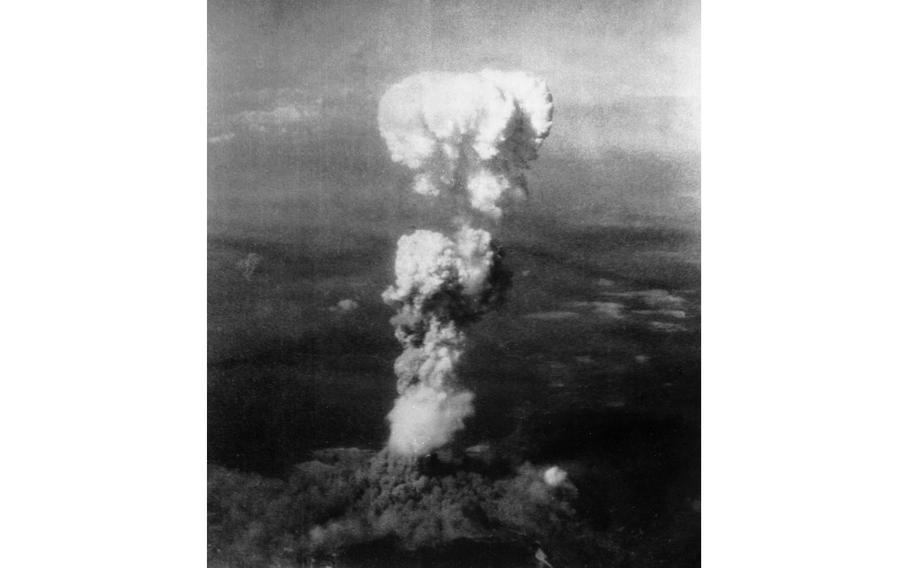
Smoke billows 20,000 feet above Hiroshima while smoke from the burst of the first atomic bomb in 1945. (Public domain/Wikimedia)
(Tribune News Service) — While the war in Ukraine raged in 2022, the world’s stockpile of functioning nuclear weapons grew, continuing a concerning yearslong trend, according to a new report.
The enlarged global arsenal now comprises about 9,576 operational warheads. Combined, they have the destructive power of roughly 135,000 Hiroshima bombs, according to a report published Wednesday by Norwegian People’s Aid, a global nonprofit organization.
The United States and Russia — which collectively possess the lion’s share of the world’s atomic weapons — dismantled a small amount of retired warheads in 2022, bringing down the total number of weapons.
But, five countries expanded their arsenals, increasing the overall supply of functioning weapons. Those countries were: Russia, China, India, Pakistan and North Korea, according to the report.
China rapidly grew its relatively small nuclear arsenal in 2022 and aims to “dramatically” expand it over the next decade, according to the report. India and Pakistan — neighbors with icy relations — are currently building up their nuclear triads, which are composed of air, land and sea capabilities.
“This increase (in functioning nuclear weapons) is worrying, and continues a trend that started in 2017,” Grethe Lauglo Østern, the editor of the report, stated in a news release. “If this does not stop, the total number of (both functioning and nonfunctioning) nuclear weapons in the world will also soon increase again for the first time since the Cold War.”
At its current size of nearly 10,000 serviceable warheads, the arsenal contains significantly more than enough firepower to imperil humanity, studies and reports have warned.
A nation that launches more than 100 nuclear weapons — and is not subject to retaliation — would “cause unacceptable damage to their own society,” according to a study published in 2018 in the journal Safety.
The scientists who constructed the earliest atomic bombs reached a similar conclusion over 70 years ago, stating that the detonation of 10 to 100 “super” bombs would threaten human civilization, according to Business Insider, citing declassified Los Alamos laboratory documents.
Alongside the growing arsenal, fear of nuclear war has also increased and is now at its highest level since the Cold War, according to the report. A spokesperson for the International Campaign to Abolish Nuclear Weapons told McClatchy News this increased fear is attributed to both public polling on the topic and increased threats from Russia.
Russian President Vladimir Putin placed his country’s nuclear forces on high alert shortly after the invasion of Ukraine, according to Reuters. He also stated several times that he would use nuclear weapons to defend Russia.
Putin announced Russia will station tactical nuclear weapons in neighboring Belarus on March 25, according to the Associated Press.
Largely in response to the war in Ukraine, the Bulletin of the Atomic Scientists decided to push the hands forward on the Doomsday Clock, a device meant to symbolize humanity’s proximity to destruction, in January.
“The Clock now stands at 90 seconds to midnight—the closest to global catastrophe it has ever been,” the bulletin’s website states.
Some nuclear experts have said the risk of nuclear war is small, but nevertheless worrisome, according to previous reporting from McClatchy News.
“When the consequences are so astronomical as to include the end of life on Earth as we know it, even a very low probability can translate into an uncomfortable level of risk,” Derek Johnson, managing partner of Global Zero, an organization dedicated to eliminating nuclear weapons, said. “And that’s on a comparatively peaceful day, never mind in the middle of a crisis.”
Currently 139 countries, including all of Africa and most of the Americas, support the Treaty on the Prohibition of Nuclear Weapons, the “only legally binding global treaty that outlaws nuclear weapons,” according to the report.
Forty-three states remain opposed to the treaty, including Russia, China and the United States.
©2023 The Charlotte Observer.
Visit charlotteobserver.com.
Distributed by Tribune Content Agency, LLC.